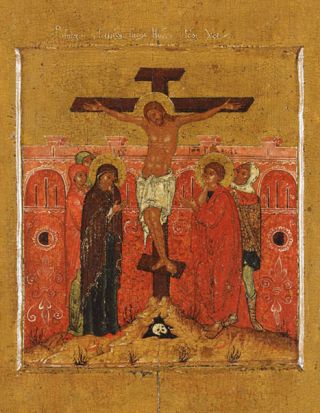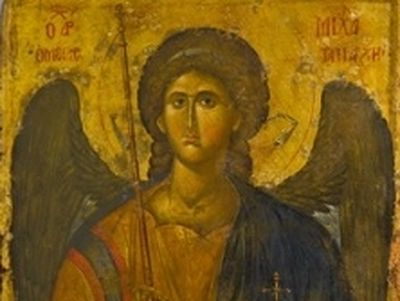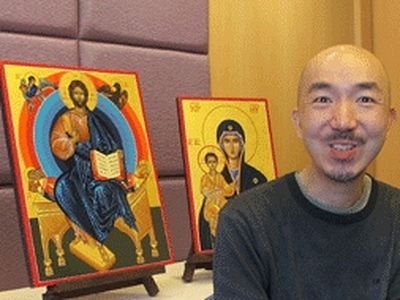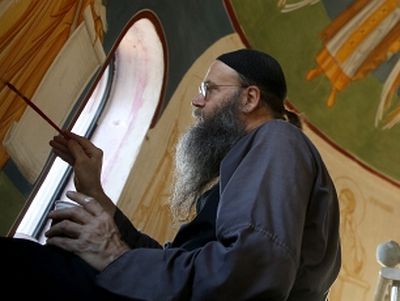Source: Neoskosmos.com
Drawing on the rich tradition of Orthodox Christian spirituality and imagery, a collection of over 80 icons - by Greek and Russian masters - will be exhibited at the Art Gallery of Ballarat.
 Crucifixion, Russia, late 17th century (private collection, Sydney).
Crucifixion, Russia, late 17th century (private collection, Sydney).
Dictionaries define an icon as an 'image'. In the Orthodox Church an icon is a sacred image, often referred to as a window into heaven. More than art, icons have an important spiritual role.
This rich tradition of Eastern Christian spirituality will be celebrated in the exhibition EIKON: Icons of the Orthodox Christian World, to be opened at the Art Gallery of Ballarat on Saturday 18 October.
For gallery director and curator of the exhibition, Gordon Morrison, the connection with Byzantine art goes much further than just another exhibition.
Despite his rather Scottish sounding name, Morrison's mother was Polish - and Poland was one of those Catholic countries that historically extended into the Orthodox world. The art form of icon painting was not strange to Morrison, whose Polish grandmother was an icon painter herself, educated during World War II.
"Byzantine art was an area of particular interest to me. But I never thought there would be an opportunity to work on a project like this - as I thought there were no major collections of Orthodox icons in the country outside of churches," Morrison tells Neos Kosmos.
It was only a couple of years ago that he was made aware of the fact that one of Australia's leading former diplomats, John McCarthy, has been quietly putting a collection of Orthodox icons for close to 30 years.
The icons exhibition at the Art Gallery of Ballarat, on display for four months, draws mainly from the magnificent private collection of Mr McCarthy, with additional loans from the National Gallery of Victoria, from the Abbey Museum of Art and Archaeology in Queensland and from Sir Richard Temple Bt, whose Temple Gallery in London is a leading centre for the study, restoration and exhibition of ancient icons and sacred art.
Most of the icons in the show - around 80 of them - originate from Greece and Russia, with examples from Cyprus, Syria and Palestine, and range in time from the 12th to the beginning of the 19th century.
Viewing the exhibition will be a special event, Morrison says, with dramatic lighting and a soundscape incorporating traditional chanting, bells and other sounds of an Orthodox service, recreating the original setting of the works.
The exhibition will explain the origins of icons,
exploring their meaning to communities who create and
venerate them and their impact on cultures who
have come in contact with them.
Morrison believes the exhibition will not only strike a chord with Christians of all denominations but appeal to those looking for a more profound and mystical understanding of spirituality, giving the visitor insights into their extraordinary power to sustain and shape belief in different times.
"While on one level icons are sacred portraits, in a deeper sense they represent the Divine Presence," he says.
"Icons are far more than two-dimensional images of Christ, the angels and saints. They are a powerful form of visual prayer that has been integral to the devotional practice of Eastern Christianity for 1,500 years."
Cretan School
The exhibition brings together high quality examples of Orthodox art, which has hardly ever been shown in Australian art galleries. Among subjects are icons depicting Christ, the Crucifixion, St Nicholas, Saint George with the Dragon, the Mother of God, the Fiery Ascent of Elijah.
A highlight of the exhibition, according to curator Gordon Morrison, is a group of late 15th century icons from Crete, which became a centre of icon painting after the fall of Constantinople in 1453.
"Crete became a refuge for icon painters in this time, and the paintings produced there combined the grand traditions of Byzantium with subtle influences creeping in from Western Europe. People familiar with the paintings of Cretan-born artist El Greco will see exactly what motivated his art when they see these images."
Ruled by somewhat tolerant Venetians, Crete was a fertile land for icon painting.
"Although they were Catholic, they were slightly more
tolerant than the Ottoman Empire. It was not necessarily
easy to practice Orthodoxy at all times in
Crete, but it was definitely easier than anywhere
else," Morrison explains.
Crete was also a very wealthy community, with its developed trade enabling the islanders to move freely. After Constantinople fell to the Turks in 1453, most of the renowned artists and icon painters fled to Candia - nowadays Iraklion - to set up art schools.
Icons were created by priests and monks, but more importantly, there were family workshops. Crete of the 15th and 16th century was the most important area in the Greek-speaking land where the icons were being produced. In those family workshops traditional techniques were passed on from father to son, from father to nephew. Work was commissioned in Crete for Mount Athos, the centre of the Orthodox Christianity.
"It has always been regarded as a holy activity and it's very different from western art where the name of the artist is almost more important than the art work itself. Many icons are actually anonymous, as traditionally artists were not expected to sign their works."
Around 1800, influences from Western Europe brought the ancient icon painting tradition close to an end. The tradition has been somewhat revived in Greece and Russia since.
In Morrison's eyes, icons are powerful form of visual prayer - that's why he finds it of utter importance for visitors with no connection to Orthodox Christianity to realise that these are not just pretty pictures there to decorate the inside of the church or to tell people stories about saints from the past.
"The most important thing about an icon in Orthodox Christianity is that when you pay respect or venerate the person that is represented in that image, you are actually passing on your respect to the individual that is behind that image. You are not venerating the gold and the paint and the wood.
"It's a very complex philosophical concept and it was a very important thing that had to be resolved, because in the Old Testament there is the ruling that you can't have any veneration of painted images, or the idols.
"For many Catholics the images exist to be more like a teaching tool, to explain a story from the past. But that's not the primary function in Orthodoxy - it is to enable the person who is inside that church to make a direct connection with the saints, with the Mother of God or with Jesus Christ."
Ranging from those used in private houses to triptychs or diptychs - multi-panel paintings - the largest works featured at the exhibition come from the iconostasis of churches and had a public use originally.
With the Art Gallery of Ballarat famous for its displays of Australian art, gallery director Gordon Morrison says the icons exhibition comes as a change.
"It's a really important exhibition for us, a little bit different to what we normally do. I think Orthodox Christian icons are quite mysterious to a lot of people - they are not sure what they are, and the most important effort of this show is that we are not just showing them as beautiful images on the wall - we want to actually show that they come from a really important Christian tradition, that a lot of people from a western background have ignored or trivialised in the past. So we try to show them in the context of religion, in which they were originally produced."
The exhibition 'EIKON: Icons of the Orthodox Christian World' is on from Saturday 18 October 2014 to Monday 26 January 2015, at the Art Gallery of Ballarat, 40 Lydiard Street North, Ballarat. The gallery is open from 10.00 am to 5.00 pm daily. For a program of educational and public events, including concerts of Greek and Russian-inspired music that will accompany the exhibition, visit www.artgalleryofballarat.com.au



